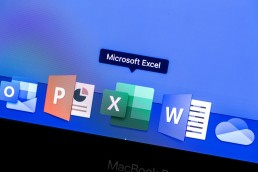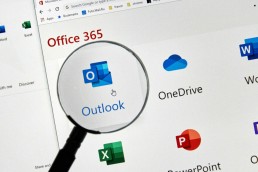Change Outlook signature - this is how!
Change Microsoft Outlook Signature - explained quickly and easily!
How to change the Outlook signature? In the past, when all letters were still sent in paper form, the so-called farewell formula could not be missing under any circumstances. Something like „Best regards“ or „Yours sincerely“ and a personal signature was a must. But who actually says that this should no longer be the case in e-mail correspondence today? If you work with Microsoft Outlook, for example in Windows 11 or Windows 11 Home, you can easily create an Outlook signature and change it at any time.
Do I have to create an Outlook signature?
That depends on whether you are writing a purely private or a business e-mail. In the business sector, a signature has been mandatory for e-mails since 2007. This means that for self-employed persons, freelancers or companies, as soon as they send an invoice or an offer by e-mail, the same information as in an imprint must be included as sender information. These minimum details are mandatory:
- Name of the company
- full name of the owner
- address for service
Fortunately, this can be done almost in a flash with Microsoft Outlook 2021. And a great company logo, a ready-made signature or even a portrait of the sender can also be integrated quite easily when you want to create the Outlook signature.
And this is how it’s done
For example, in the Microsoft Outlook 2019 Multilanguage full version with the Windows 11 Pro or Windows 11 Pro N operating system, signatures can be automatically attached to all outgoing mails. It is also possible to add a signature to individual e-mails. If you want to change an Outlook signature, proceed in the same way:
- First open a new e-mail message.
- Select the option „Signature“ in the “ Message “ menu.
- Under „Signature to edit“, select the option „New“.
- In the „New Signature“ dialogue box, give the signature a name.
- Use „Edit signature“ to write the personal farewell formula. The font, font size, text alignment and colour can be easily specified. If you want to change the Outlook signature later, each individual point can also be edited later.
- Using the option „Select default signature“ in the drop-down menu „E-mail account“, first select the corresponding account to which the signature is to be assigned.
Tip: Each e-mail account in Outlook, for example in Windows 11 Education, can be given its own individual signature. The more individual and specific these are, the more personally the recipients feel addressed. In a business context, this can have a more professional effect.
- If all messages are to receive the signature, select one of the signatures in the drop-down menu „New messages“ .
- If you do not want all new messages to automatically receive a signature, simply click (none)
- If the signature is also to be shown on reply mails or forwards, select an appropriate signature under „Replies/Forwards“.
- If this is not necessary, select the standard option ( none).

Add signature manually one by one
If you have decided not to automatically add a signature to every e-mail, you can still add a signature, address, picture, etc. to individual e-mails afterwards. Select an individual e-mail and choose the „Signature“ option on the „Message“ tab. In the flyout menu, each signature created can now be selected to be displayed under the individual message.
Add picture, logo and signature
With Microsoft Outlook, a signature with pictures can also be created or the Outlook signature can be changed accordingly under Windows 11 Enterprise and Windows 11 Pro for Workstation.
- To do this, select Signature> Signatures in a new e-mail.
- In the field „Select signature for editing„, click on the signature that is to be provided with a logo, a picture or with the digitised signature (as a picture).
- Now select a corresponding image file on the PC with the icon Image and connect it to the signature by clicking on „Insert“.
- Right-click on the image under the „Size“ tab to adjust the area of the image.
Tip: If the checkbox „Lock aspect ratio“ is activated, the image ratios are preserved.
Header image: ©monticellllo, stock.adobe.com
Link Outlook, Word and Excel
Link Outlook, Word and Excel - this is how it works!
In this article we show you how to link Microsoft Outlook, Word and Excel. Whether for private or business use – the Office Suite on the PC facilitates many work processes and enables a clean presentation of a wide variety of documents. Microsoft Word can be used to create formatted texts, Microsoft Excel is the top programme for spreadsheets, calculations and data processing. And finally, Microsoft Outlook is used to manage all e-mails and organise appointments with the help of the integrated calendar.
Linking Word and Excel
In everyday office life, it is often necessary to integrate a table into a Microsoft Word document. This can either be created in the programme itself – or simply linked to a table in Microsoft Excel. To do this, first open the corresponding Excel file. Now mark the table or individual sections of the table and copy them with the keyboard command „CTRL+C“. Then open the Microsoft Word document into which the table or parts of it are to be inserted. Now direct the cursor to the place where the table is to appear. With the keyboard command „CTRL+V“ you can now place it exactly there. The disadvantage, however, is that changes to the table can now only be made with the functions of Microsoft Word. It is more convenient to be able to insert an Excel link into Word. How to link Word with Excel:
- First, select the corresponding table in Microsoft Excel and copy it using the shortcut command.
- In the Microsoft Word document, click on the arrow under „Insert“ in the „Start“ tab and select „Insert contents“ in the drop-down menu.
- In the new window, click on „Insert link“.
- Then select „Microsoft Excel Workbook Object“ in the menu window and confirm with „Ok“.
- Changes that are now made to the table in Microsoft Excel automatically appear in the Microsoft Word document.

Linking Microsoft Outlook with Word and Excel
With a Microsoft account, it is easy to harmonise the functions of all three tools. So not only Excel links can be inserted into Word. But tasks, appointments and changes can also be viewed on different end devices by different employees. The first step is to prepare the toolbar for quick access.
- To do this, right-click on a symbol in the toolbar.
- Select the option „Customise the quick access toolbar“. A new dialogue box opens (depending on the selected programme in Microsoft Word or Microsoft Excel).
- In the „Quick Access Toolbar“ entry in the navigation bar, in the „Select Commands“ list field, select the item „Commands not included in the ribbon“.
- Click on „Create Microsoft Outlook task“ in the list and activate it.
One of the advantages of this option is that the document sent via Microsoft Outlook remains on the original PC. Before it is sent, it can be „released“ or „locked“ so that editing by others is prevented or made possible. In this way, tasks can be distributed quickly and without effort by switching programmes. It makes sense to distribute tasks, for example, when working on a Word document or an Excel spreadsheet. And the employee needs to be informed about a current change of deadline, for example. Then this new task does not have to be created in Microsoft Outlook first. Instead, it can be displayed directly in the document being worked on. If there are no other tasks associated with the document, it can be sent to all or individual contacts from the address book in Outlook – without having to change the programme. New recipients can also be added at any time using the table function.
Tip: Working with highlighters in Microsoft Word documents
If several people are working together on a Microsoft Word document, it makes sense to mark particularly important text passages with markers. Such bookmarks make it possible to find certain sections of the text quickly, especially in an extensive document or a shared directory that has been shared with Outlook. Previously uninvolved contacts can then continue to work on these as a task, for example, or make changes.
Header Image: © Prima91, stock.adobe.com
Sort Outlook mails automatically - this is how it works!
Sort Outlook mails automatically - this is how it works!
Office management without Outlook? Almost unthinkable! From receiving and sending e-mails to calendar management and tracking tasks to storing all contact data, the programme in Microsoft Office 365 on Windows 11 is a real jack-of-all-trades. But what many people don’t know: You can also sort mails with Outlook and move Outlook mails automatically.
Sort Outlook mails
In order not to lose the overview in the overflowing mailbox, you can sort Outlook mails by size with Microsoft Outlook 2019. But also by sender name, read or unread messages, subject or date. If you want to sort Outlook mails by size, the procedure is very simple:
Sort Outlook mails by size
- In the inbox, first click on „Filter“ in the upper area.
- Now various options appear under „Sort by“, here select „Size“.
Sort Outlook mails by subject line
The programme also allows you to sort mails not only by size and other options, but also by certain keywords in the subject line. To do this, first create a subfolder in which every incoming mail containing this keyword in the subject line is automatically filed. The prerequisite for this is, of course, that the sender also knows and uses this keyword so that Microsoft Outlook 2019 recognises that it should sort this mail.
- Click on the relevant mail and select the „Start“ tab.
- Next, click on „Rules“, then select the option „Create rule“.
- In the subsection „If an incoming message meets all conditions“ in the „Create rule“ dialogue box, activate „Subject contains“.
- Enter the keyword in the corresponding text field.
- Now go to the subsection „Execute the following“ and select the created and named subfolder under „Move item to folder“.
- Press the „OK“ button and answer the control question with Yes.
Move Outlook Mails Automatically
With hundreds of mails arriving in a short period of time, confusion can quickly arise. A function of Microsoft Outlook 2019 as part of Microsoft Office 365 in Windows 11 helps to create clarity and order. This is the option to automatically move certain Outlook mails to previously created subfolders with the corresponding names.
- First, click on the e-mail folder with the right mouse button.
- A context menu appears. Select the option „New folder“.
- Each new folder must now be given its own name.
In order to be able to sort the individual Outlook mails so that they are automatically placed in the correct folders according to the specifications, a few rules must be set:
Automatically move Outlook mails to folders
If, for example, you want to move all Outlook mails from a certain sender automatically into folders, first click on any mail from this sender.
- Select the „Rules“ option on the „Start“ tab.
- In the context menu that appears, select the option „Always move messages from (name)“.
- Now just select the corresponding, previously named subfolder in the „Rules and Notifications“ dialogue box and click the OK button.

More tips
Time-shift sending: With Microsoft Outlook 2019, you can also send mails at a later time. To do this, select the „Options“ tab, go to the „Delay transmission“ button and select the date and time in the dialogue box. Then click on „Send“ as usual. Automatic forwarding: Before sending a mail, click on the „Options“ button and select „Reply directly to“. Then enter the desired recipient under „Forwarding functions“. The reply mail is now automatically sent to the selected recipient – for example, to a colleague if you are on holiday yourself. Recalling mails: If you have sent a mail by mistake, you can edit it with the „Actions“ button. After clicking on the corresponding mail, select the option „Recall this message“. Then select either „Delete unread copies of this message“ or „Replace unread copies with a new message“. Now the mail is deleted at the recipient’s or replaced by a corrected or extended mail. However, this only works if the recipient has not yet opened the original message.
Header image: © Leowolfert, stock.adobe.com
Microsoft Outlook: Kalender freigeben - Verständlich erklärt
Microsoft Outlook: Kalender freigeben - Verständlich erklärt
Um die Abstimmung bei Team- bzw. Gruppenterminen wesentlich zu vereinfachen, kann man den Kalender in Microsoft Outlook freigeben. Voraussetzung dafür ist ein Microsoft Exchange Konto. Aber auch wenn man kein solches Konto besitzt, gibt es nützliche alternative Möglichkeiten. Es stehen drei verschiedene Optionen zur Auswahl:
⦁ Kalender freigeben
⦁ Kalender per E-Mail senden
⦁ Online veröffentlichen
Kalender freigeben
Dafür müssen ebenfalls die Person bzw. Personen, mit denen der Kalender geteilt und genutzt werden soll, über ein Microsoft Exchange Konto verfügen. So funktioniert es:
Kalender-Bereich in Outlook öffnen:

Auf „Kalender freigeben“ klicken, ein neues Fenster öffnet sich. Hier im Feld „An“ die Mailadresse der Person eintragen, die Zugriff auf den Kalender haben soll. Um ebenfalls Berechtigungen zum Anzeigen des Kalenders des Empfängers haben, das Häkchen im Feld „Berechtigung zum Anzeigen von ‚Kalender‘ des Empfängers anfordern“ setzen. Im Anschluss auf „Senden“ klicken und die Freigabeeinladung abschicken.
Handelt es sich bei dem Kalender, der freigegeben werden soll, nicht um den Standardkalender, sondern um einen eigens erstellten Kalender, im Navigationsbereich mit Rechtsklick auf den Kalendernamen klicken und die Option „[Kalendername] freigeben“ auswählen.
Soll ein Kalender angezeigt werden, der von einem Kollegen freigegeben wurde, auf „Kalender öffnen“ klicken und im Drop-Down Menü „Adresse auswählen“. Die gewünschte Adresse auswählen und den Kalender des Kollegen neben dem eigenen anzeigen lassen:

Kalender per E-Mail senden
Verfügt man nicht über ein Microsoft Exchange Konto, kann man alternativ den Outlook Kalender per E-Mail senden. Der Kalender wird dabei als Momentaufnahme im Anhang verschickt und gleichzeitig im Nachrichtentext angezeigt.
auf „Kalender per E-Mail senden“ Klicken:

In dem neu geöffneten Fenster den gewünschten Kalender auswählen und den Datumsbereich des Kalenders eintragen, der dem Empfänger angezeigt werden soll. Bei Bedarf kann man auch weitere Einstellungen festlegen. Zum Abschluss auf „Ok“ klicken.

Kalender Online veröffentlichen
Die zweite Möglichkeit, ohne ein Microsoft Exchange Konto einen Kalender mit anderen Personen teilen zu können, bietet die Online Veröffentlichung. Dabei veröffentlicht man den Kalender im Internet auf Office.com, wofür eine kostenlose Anmeldung notwendig ist.
Auf „Online veröffentlichen“ klicken und dann auf „Auf Office.com veröffentlichen“:

In dem neu geöffneten Fenster kann man, ähnlich wie beim Versenden des Kalenders per E-Mail, den gewünschten Kalender sowie den Datumsbereich und weitere Einstellungen auswählen. Die Änderungen mit „Ok“ bestätigen. Im Anschluss kann man im nächsten Fenster angeben, wer Einsicht in den Kalender erhalten soll. Nach abschließender Versendung der Einladungen werden die Empfänger per E-Mail über die Veröffentlichung des Kalenders informiert.
Header-Bild: © dennizn, stock.adobe.com
Postfach bei Outlook hinzufügen – so einfach geht’s
Postfach bei Outlook hinzufügen – so einfach geht’s
Über die Jahre haben sich – meist unbeabsichtigt, aber aus beruflichen wie privaten Gründen und Umständen – zahlreiche E-Mail Adressen angesammelt. Das ist umständlich und man verliert leicht die Übersicht oder findet im schlimmsten Fall diese eine E-Mail, die man jetzt im Moment braucht, einfach nicht auf Anhieb. Will man die neuen E-Mails dieser ganzen Adressen abfragen, braucht man sich aber nicht überall einzeln anzumelden. Das Programm Outlook bietet die Möglichkeit, mehrere Postfächer zu sammeln, womit man die gesamte elektronische Post im Blick hat. Wir zeigen, wie einfach es geht, Postfächer bei Outlook hinzuzufügen. So einfach geht’s:
Das Einrichten eines weiteren E-Mail-Kontos bei Outlook fällt erfreulicherweise recht simpel aus:
- Datei wählen, den Reiter Informationen und anschließend auf „Konto hinzufügen“ klicken.


- An dieser Stelle Name des Nutzers, die E-Mail-Adresse und das dazugehörige Passwort eingeben.

- Mit „weiter“ die Daten bestätigen.
- Outlook überprüft dann die eingegebenen Daten auf Korrektheit. Stimmt alles, ist der Installationsprozess abgeschlossen.
- Zuletzt auf „Fertig stellen“ klicken und das neue Postfach ist hinzugefügt.
Achtung: Hat man zu viele Postfächer mit Inhalten von großen Datenmengen hinzugefügt, kann das bei Outlook – und auch bei anderen Anbietern – zum Teil zu erheblichen Leistungsschwankungen führen. Dann ist es ratsam, unwichtigere Daten in regelmäßigen Abständen zu löschen und wichtige Dateien beispielsweise auf einer (externen) Festplatte zu speichern.
Geteiltes Postfach in Outlook
Mit geteilten Postfächern können bestimmte Personengruppen E-Mails über einen öffentlichen E-Mail-Alias wie etwa „info@xy.com“ oder „kontakt@xy.com“ auf einfache Weise überblicken und senden. Antwortet eine Person in der Gruppe auf eine Nachricht, ist als Absender der E-Mail das geteilte Postfach zu sehen und nicht der einzelne Benutzer. Außerdem kann das geteilte Postfach als freigegebener Teamkalender fungieren. So einfach geht’s:
- In Outlook die Registerkarte Datei im Menüband auswählen.
- Kontoeinstellungen und dann Kontoeinstellungen im Menü auswählen.

- Die Registerkarte „E-Mail“ auswählen.
- Sicherstellen, dass das richtige Konto hervorgehoben ist, dann „Ändern“ auswählen.

- Weitere „Einstellungen“ > „Erweitert“ > „Hinzufügen“ auswählen.

- Die geteilte E-Mail-Adresse eingeben, „OK“ auswählen und
- Weiter > Fertig stellen > Schließen auswählen.
Ein geteiltes Postfach ist allerdings nicht für direktes Anmelden ausgelegt. Das Benutzerkonto für das geteilte Postfach selbst sollte den Status „deaktiviert“ behalten.
Outlook mit Exchange verbinden
Zu einem existierenden POP3- oder IMAP-Konto kann man ein Microsoft-Exchange-Konto in Microsoft Outlook 2019 einrichten. So einfach geht’s:
- Datei wählen, den Reiter Informationen und anschließend auf „Konto hinzufügen“ klicken.

- Die E-Mail-Adresse des neuen Microsoft Exchange 2019-Kontos eingeben, auf „Erweiterte Optionen“ klicken, die Option „Ich möchte Mein Konto manuell konfigurieren“ aktivieren und anschließend auf „Verbinden“ klicken.

- Den Kontotyp „Exchange“ wählen

Der Computer stellt jetzt eine Verbindung zu den Microsoft Exchange-Servern her.
Folgende Meldung wird angezeigt:
„Durch das Hinzufügen eines neuen Microsoft Exchange-Kontos haben Sie den Speicherort für einige Ihrer neuen E-Mail-Nachrichten und Kalenderinformationen geändert.“
- Auf „OK“ klicken.
Man wird aufgefordert, Autodiscover zu autorisieren, Microsoft Outlook in seinem Namen einzurichten.
- Auf „Zulassen“ klicken.
- Passwort eingeben und auf „OK“ klicken.
Das Fenster Kontoeinrichtung abgeschlossen wird angezeigt.
- Auf „OK“ klicken.
Das Microsoft Exchange-Konto ist jetzt eingerichtet und einsatzbereit.
Hat man in Microsoft Outlook 2019 schon ein Profil für ein Microsoft-Exchange-Konto erstellt und möchte ein zusätzliches Microsoft-Exchange-Konto nutzen, muss man dafür ein neues Profil erstellen.
Header-Bild: © IB Photography, stock.adobe.com





